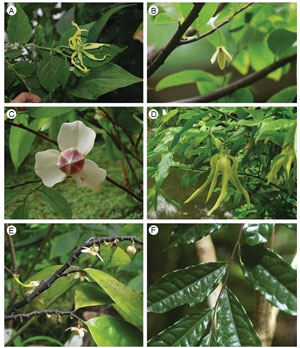
番荔枝科隶属于木栏目,为原始被子植物,其花的形态具有很高的多样性。中科院华南植物园植物系统与进化研究领域徐凤霞研究员与英国爱丁堡皇家植物园Ronse De Craene博士对番荔枝科15个种的花发育进行研究后发现,该科花原基分生组织变异很大,具有三基数和四基数类型及之间的过渡类型,一些类群的内轮花被片还会分裂成两个。该科大多数类群雄蕊和心皮的数目均不确定,雄蕊最初均是成(3)对发生,雄蕊数目的增加与它们发生时体积变小有关系。在发育早期,雄蕊与心皮之间不能清楚区分,相互之间的转化常常发生,当发生心皮的位置完全被雄蕊取代时,则成为单性花。
该研究加强了对原始被子植物花形态变异及其进化本质的理解。相关研究结果已于近期在线发表在国际著名学术刊物Annals of Botany上。(生物谷Bioon.com)
生物谷推荐英文摘要:
Ann Bot (2010) doi: 10.1093/aob/mcq158
Floral ontogeny of Annonaceae: evidence for high variability in floral form
Fengxia Xu1 and Louis Ronse De Craene2,*
1South China Botanical Garden, Chinese Academy of Sciences, 723 Xinke Road, Tianhe District, Guangzhou China 510650
2Royal Botanic Garden Edinburgh, 20 Inverleith Row, Edinburgh EH3 5LR, UK
Background and Aims Annonaceae are one of the largest families of Magnoliales. This study investigates the comparative floral development of 15 species to understand the basis for evolutionary changes in the perianth, androecium and carpels and to provide additional characters for phylogenetic investigation.
Methods Floral ontogeny of 15 species from 12 genera is examined and described using scanning electron microscopy.
Key Results Initiation of the three perianth whorls is either helical or unidirectional. Merism is mostly trimerous, occasionally tetramerous and the members of the inner perianth whorl may be missing or are in double position. The androecium and the gynoecium were found to be variable in organ numbers (from highly polymerous to a fixed number, six in the androecium and one or two in the gynoecium). Initiation of the androecium starts invariably with three pairs of stamen primordia along the sides of the hexagonal floral apex. Although inner staminodes were not observed, they were reported in other genera and other families of Magnoliales, except Magnoliaceae and Myristicaceae. Initiation of further organs is centripetal. Androecia with relatively low stamen numbers have a whorled phyllotaxis throughout, while phyllotaxis becomes irregular with higher stamen numbers. The limits between stamens and carpels are unstable and carpels continue the sequence of stamens with a similar variability.
Conclusions It was found that merism of flowers is often variable in some species with fluctuations between trimery and tetramery. Doubling of inner perianth parts is caused by (unequal) splitting of primordia, contrary to the androecium, and is independent of changes of merism. Derived features, such as a variable merism, absence of the inner perianth and inner staminodes, fixed numbers of stamen and carpels, and capitate or elongate styles are distributed in different clades and evolved independently. The evolution of the androecium is discussed in the context of basal angiosperms: paired outer stamens are the consequence of the transition between the larger perianth parts and much smaller stamens, and not the result of splitting. An increase in stamen number is correlated with their smaller size at initiation, while limits between stamens and carpels are unclear with easy transitions of one organ type into another in some genera, or the complete replacement of carpels by stamens in unisexual flowers.







